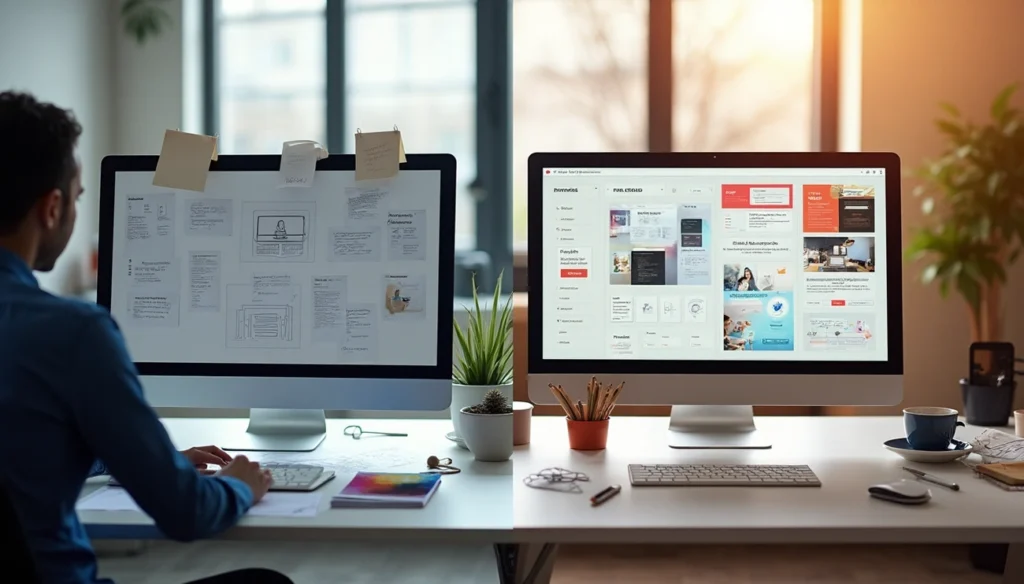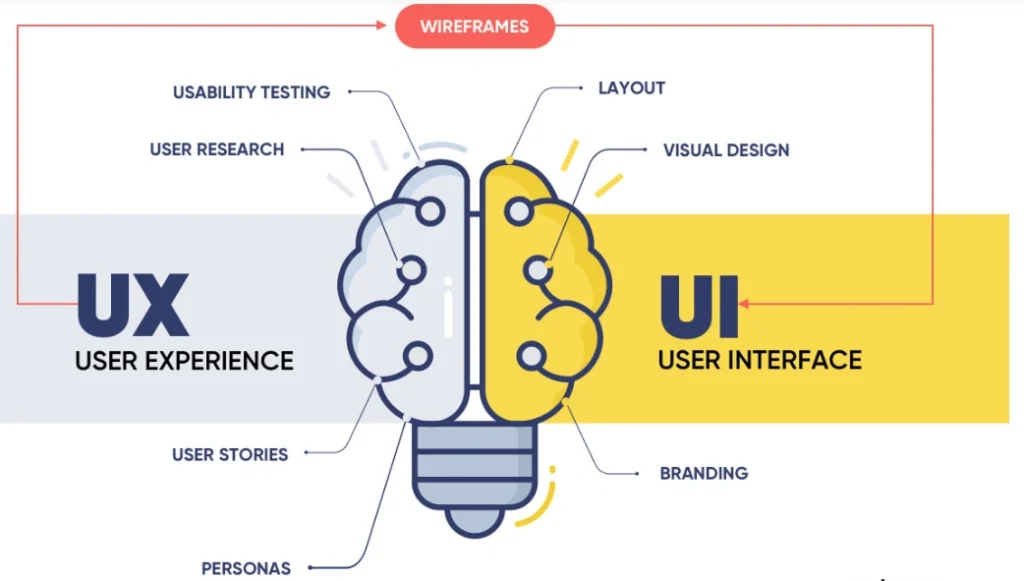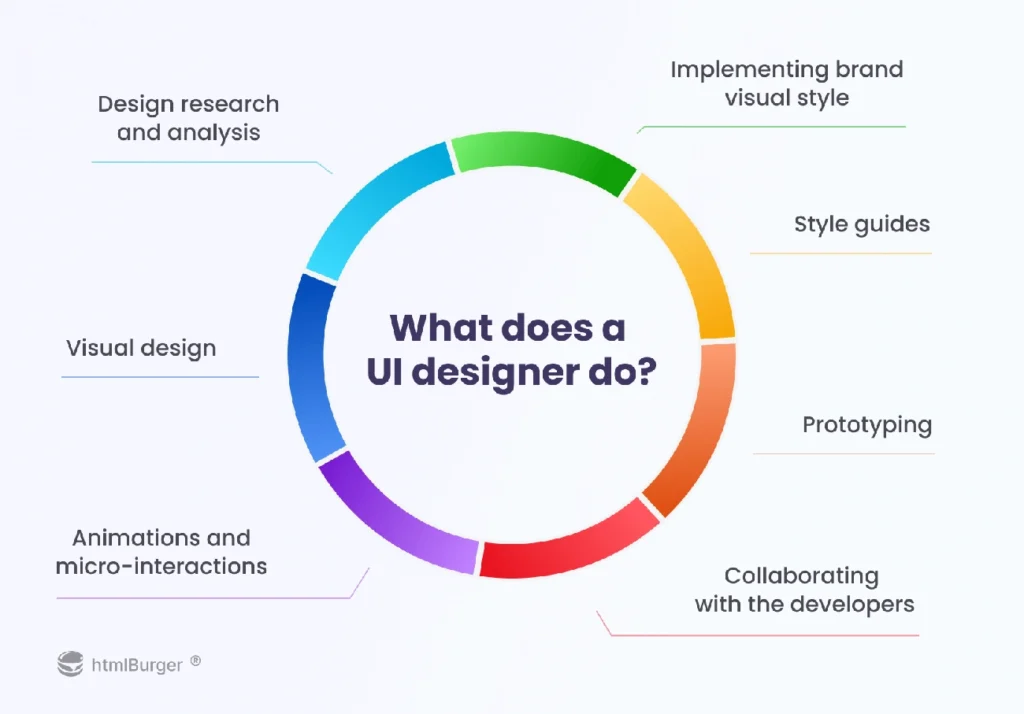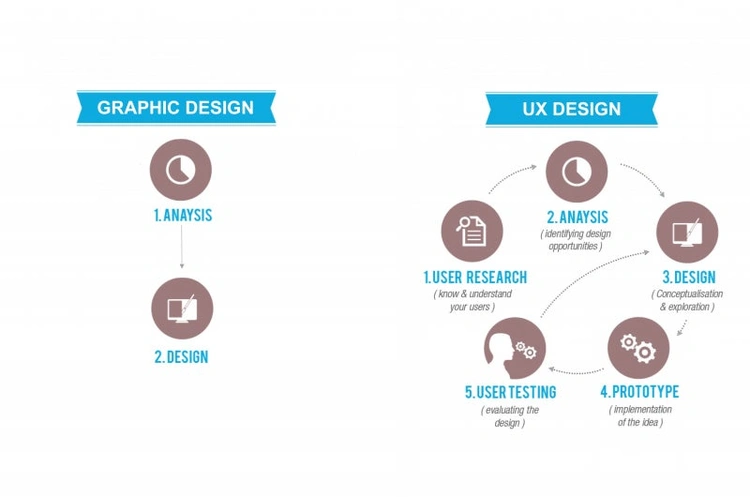
When 40% of users abandon products after a single bad experience, the stakes for getting design right couldn’t be higher. UX design and UI design get thrown around interchangeably in conversations, but they tackle completely different problems in product development. UX design shapes the entire journey users take through your product, while UI design focuses on the specific visual elements—buttons, menus, forms—that users actually touch and click.
I’ve watched teams struggle with this distinction for years. Clients often ask for “better UX” when they really mean visual polish, or request “UI improvements” when the real issue is a confusing user flow. The confusion isn’t just semantic—it affects business outcomes. Take Trainline, the UK ticketing platform that grew from £3.2 billion to £3.7 billion in ticket sales largely by fixing their user experience, not just making things look prettier.
Both disciplines aim for the same end result: products that work well and feel good to use. When you understand what each one actually does, you can build better digital experiences and avoid the costly mistakes that come from mixing up their roles.
In this article, we’ll break down exactly what separates UX from UI design using real examples that show how they work both independently and together to create successful products.
What is the Difference Between UX and UI Design?
“UI is the saddle, the stirrups, & the reins. UX is the feeling you get being able to ride the horse.” — Dain Miller, Web Developer specializing in UX/UI design

Image Source: Squibble
The distinction becomes clearer when you look at what each discipline actually produces. Think of building a hotel: UX designers work like architects, planning how guests will move through spaces and accomplish their goals. UI designers function as interior designers, choosing the furnishings, colors, and visual elements that make each space appealing and functional.
UX Design: Focus on user journey and experience
UX design encompasses the complete experience someone has with your product, from first contact to final interaction. UX designers map out every step users take to accomplish their goals, then optimize those pathways to remove friction and confusion.
The work is fundamentally human-centered—UX designers solve problems people actually have rather than problems that seem interesting to solve. Unlike UI design, UX principles apply to both digital and physical products. You’ll find UX thinking in everything from airport wayfinding systems to mobile apps.
A UX designer’s typical workflow includes:
- Conducting user research to identify goals, needs, and pain points
- Creating user personas and journey maps
- Developing wireframes and prototypes
- Performing usability testing to validate design decisions
Don Norman, who coined the term “user experience” in the late 1990s, explains it this way: “User experience encompasses all aspects of the end-user’s interaction with the company, its services, and its products”. The goal is eliminating unnecessary difficulty—what we call friction—from user interactions.
UI Design: Focus on visual and interactive elements
UI design handles the specific elements users see and interact with on screens. Buttons, menus, forms, icons, color schemes, typography—if it appears on a digital interface, it falls under UI design.
UI designers take the structural blueprints from UX designers and create the visual components that bring them to life. Their focus areas include:
- Organizing page layouts
- Selecting color palettes, typography, and imagery
- Designing interactive elements like buttons, menus, and form fields
- Creating high-fidelity wireframes showing the final visual design
UI design differs from graphic design in one crucial way: UI designers create interactive visual elements, while graphic designers typically work with static designs. A UI designer must consider not just aesthetics, but also what happens when someone clicks, taps, or hovers over each element.
How UX and UI complement each other
These disciplines depend on each other throughout product development. UX typically comes first, establishing the foundation, then UI adds the visual layer.
Here’s how they typically collaborate:
- UX designers identify problems and map out the user journey
- UI designers create the visual elements that guide users through that journey
- Both teams iterate based on user feedback and testing
Jonathan Widawski, CEO of Maze, puts it well: “We shouldn’t talk about UX vs. UI. Instead, it should be UX and UI because they overlap and complement each other”. This collaboration produces products that work well and look good doing it.
Consider an e-commerce checkout flow: UX designers determine the optimal sequence of steps and information needed. UI designers then use visual hierarchy, color, and layout to guide users smoothly through that process. Neither approach works without the other—you need both the strategic thinking and the visual execution.
Key Responsibilities of UX vs UI Designers

Image Source: htmlBurger
The day-to-day work of UX and UI designers looks completely different, even when they’re working on the same product. Understanding what each role actually does helps teams collaborate more effectively and prevents the common mistake of asking designers to do work outside their specialty.
UX Tasks: Research, wireframing, user flows
UX designers spend most of their time understanding users before they design anything. They start with research—interviews, surveys, usability tests—to figure out what people actually need and where current products fall short. This research becomes the foundation for every design decision that follows.
Once they understand user needs, UX designers map out how people should move through a product. This involves:
- Cataloging touchpoints where users interact with data or make decisions
- Grouping information in ways that match how users think about tasks
- Testing navigation structures through card sorting and tree testing
Wireframing represents the bridge between research and visual design. These rough sketches lay out where everything goes on a page without getting distracted by colors or fonts. Think of wireframes as the blueprint that shows which rooms go where in a house, but doesn’t specify paint colors or furniture.
User flows diagram the complete path someone takes to accomplish a goal. UX designers create these maps early in the process to identify potential problems before any code gets written. A good user flow shows every decision point, error state, and alternative path users might take.
UI Tasks: Visual design, prototyping, responsiveness
UI designers take the structural work from UX and make it look and feel great. They receive wireframes and user flows, then figure out how to bring those concepts to life through visual elements that people can actually interact with.
Visual design forms the core of UI work:
- Color systems that guide attention and communicate meaning
- Typography choices that improve readability and brand consistency
- Interactive elements like buttons, forms, and navigation menus
- Animation and transitions that help users understand what’s happening
Prototyping allows UI designers to test their visual decisions before development begins. These prototypes range from simple clickable wireframes to high-fidelity mockups that look and behave like the final product. Good prototypes help teams catch usability issues and alignment problems early.
Responsive design ensures interfaces work across different devices and screen sizes. UI designers must consider how their layouts adapt from desktop to tablet to mobile, making sure touch targets stay accessible and content remains readable regardless of screen size.
Where their roles overlap in product development
While UX and UI have distinct responsibilities, they collaborate throughout the entire design process. Both roles need to understand user psychology and business constraints to create solutions that actually work.
User research and testing involves both disciplines. UX designers typically lead research efforts, but UI designers need to understand user preferences to make appropriate visual choices. When testing prototypes, both contribute insights about what’s working and what needs adjustment.
Prototyping creates the biggest overlap between roles. UX designers build low-fidelity prototypes to test concepts and user flows. UI designers create high-fidelity versions that test visual design and interaction details. Many teams have designers who handle both types of prototyping.
The relationship works like this: UX designers identify problems and map solutions, while UI designers create the visual and interactive elements that guide users through those solutions. Both iterate based on user feedback, refining the product until it meets user needs and business goals.
Neither role can succeed without the other. UX without UI creates solutions that work but don’t feel good to use. UI without UX creates beautiful interfaces that don’t actually solve user problems.
Real-Life Examples of UX and UI in Action

Image Source: The Good
Seeing UX and UI design in everyday products makes the distinction between these disciplines much clearer. Let’s examine three common scenarios where both types of design work together—and where you can spot the difference in their approaches.
Example 1: Job application form on a website
Job application forms reveal how UX and UI designers tackle the same challenge from different angles. When someone applies for a job online, they’re entering a high-stakes situation where abandoning the form means losing a potential opportunity.
The UX designer focuses on the flow: How many questions should appear on each page? When should we ask for a resume upload versus manual entry? How do we pace the experience so people don’t get overwhelmed halfway through?
The UI designer handles the visual execution: making sure form fields are easy to read, buttons are clearly clickable, and error messages appear in the right places.
Effective job application forms typically include:
- Streamlined field selection with only necessary questions
- Left-aligned form fields and placeholders for easy reading
- Clean, single-column layouts guiding users naturally from top to bottom
- Simple input methods like calendar selectors for dates
The stakes are real here. When forms follow basic usability guidelines, users are almost twice as likely to submit without errors on the first try—78% success rate for well-designed forms versus only 42% for poorly designed ones.
Example 2: E-commerce checkout experience
The checkout process puts both UX and UI design under intense pressure. This is the moment when browsing turns into buying, and getting it wrong costs money directly.
UX design determines the checkout flow: Should payment and shipping happen on the same page? How do we handle guest checkout versus account creation? What happens if someone wants to edit their order mid-checkout?
UI design makes that flow visually clear: using progress indicators, highlighting important costs, making buttons obviously clickable, and ensuring everything works smoothly on mobile screens.
Research shows that 70% of e-commerce users abandon their purchase after adding items to their cart, making checkout optimization crucial for business success.
Well-designed checkouts share these characteristics:
- Clear order summaries with editable quantities and variants
- Transparent display of all costs upfront
- Multiple payment options presented with security indicators
- Progress indicators showing users their position in the checkout flow
When teams get both UX and UI right in checkout, the results are dramatic. Large e-commerce sites can see up to a 35% increase in conversion rate from thoughtful checkout improvements.
Example 3: Car dashboard and driving experience
Car dashboards demonstrate UX and UI design in a life-or-death context. Unlike websites where mistakes cause frustration, poor automotive interface design can cause accidents.
The UX challenge: How do drivers access navigation, climate control, entertainment, and driving assistance without taking their eyes off the road? What information do they need immediately versus what can wait?
The UI challenge: How do you make controls large enough to hit while driving, readable in bright sunlight, and usable with gloves on?
Tesla’s approach illustrates this balance—they moved most controls to a large touchscreen (UI decision) but organized functions so drivers can access critical features quickly (UX decision).
Safety drives every design choice in automotive interfaces. Instead of trying to capture attention like traditional digital products, car interfaces must be consumable at a glance. This explains why successful car interfaces feature clean, minimal designs with large text and simple controls.
UX and UI designers working on automotive projects must consider road conditions, weather, traffic, accessibility needs, and cultural differences when creating interfaces that enhance rather than distract from the driving experience.
Each of these examples shows how UX and UI design approach the same product from different directions, but both are essential for creating experiences that actually work for real people in real situations.
Common Misconceptions About UX and UI
“Perfection is achieved, not when there is nothing more to add, but when there is nothing left to take away.” — Antoine de Saint-Exupéry, French writer and pioneering aviator, known for ‘The Little Prince’

Image Source: Medium
Teams often hold misconceptions about UX and UI that create real problems during product development. These myths lead to misaligned expectations, wasted resources, and products that miss the mark with users. Let’s address the most persistent ones.
UX is not just wireframes
The biggest myth I encounter is that UX design equals wireframing. Wireframes are just one tool in a much larger toolkit. As designers have worked to prove their value to stakeholders, many have realized that spending too much time on wireframes can actually hurt their effectiveness rather than help it.
UX design is fundamentally about solving user problems before users even realize they have them. The work involves research, psychology, content strategy, marketing, interaction design, and understanding human behavior. One expert puts it well: “UX is more about science”—focusing on how users actually move through and interact with products.
UI is not just making things pretty
People often dismiss UI design as “making things look nice,” but this completely misses the strategic importance of interface design. UI designers don’t just pick colors and arrange buttons—they work on content development, research, planning, and ensuring all the visual elements function together seamlessly.
Good UI design considers business goals, accessibility, and user needs before aesthetics. You don’t need to be an artist to excel at UI design. What you need is attention to detail and a solid understanding of how visual elements can enhance or hinder usability.
Both disciplines require strategic thinking
Perhaps the most damaging misconception is that UX and UI designers don’t need to think strategically about business outcomes. This couldn’t be further from the truth. As one industry expert notes, “UX strategy is business strategy”—because end-users are the ones who ultimately pay for products and services.
Without strategic thinking, both UX and UI teams risk:
- Building features and experiences that nobody wants
- Getting called in only to “polish” experiences after major decisions are made
- Struggling to mature design practices within their organizations
Both roles demand thinking beyond immediate deliverables to consider broader business context. Too many organizations still assume they know what users want without conducting proper research, leading to misguided decisions and wasted design effort.
Tools and Skills Used in UX and UI Design

Image Source: Upforce Tech
The right tools can make or break your design process. Both UX and UI designers rely on specialized platforms to research, prototype, and collaborate, but their toolkits serve different purposes in the product development workflow.
UX Tools: Hotjar, Figma, user testing platforms
UX designers need tools that help them understand user behavior and validate their design decisions. Hotjar has become essential for behavioral analytics—it provides heatmaps, session recordings, and surveys that show exactly where users click, scroll, and struggle. With 6,000 researchers using Hotjar weekly, it’s clear that understanding real user behavior matters more than assumptions.
Figma serves double duty for UX professionals. As a cloud-based platform, it enables real-time collaboration on wireframes and prototypes without the version control headaches of traditional design files. Teams can work simultaneously on user flows and iterate quickly based on feedback.
UserTesting bridges the gap between assumptions and reality by providing access to real users who can validate design hypotheses before development begins. This prevents costly mistakes that only surface after launch.
UI Tools: Figma, Sketch, Adobe XD
UI designers focus on tools that help them create and refine visual interfaces. Figma works well for UI teams because it runs in browsers across Windows, Mac, and Linux systems. Its team libraries feature creates design systems with linked components that entire teams can use consistently across projects.
Sketch remains popular among Mac users for its vector graphics capabilities and symbol libraries that store reusable design elements. Adobe XD offers strong prototyping features, particularly its Auto Animate function that adds smooth transitions between screens. XD also supports plugins that automate repetitive tasks.
The choice often comes down to team preferences and existing workflows rather than dramatic capability differences.
Do UX/UI designers need to code?
This question comes up constantly, and the answer isn’t black and white. You can absolutely succeed as a UX or UI designer without coding skills, especially with today’s intuitive design tools.
However, understanding basic HTML, CSS, and JavaScript offers real advantages in team collaboration. As Aaron Walter from InVision puts it: “It’s not going to kill a designer if they knew a little bit about how to write some HTML and CSS, maybe a little bit of JavaScript”. This knowledge helps you communicate more effectively with developers and create designs that are actually feasible to build.
The key is understanding your role and team structure. If you’re working closely with developers, some technical knowledge helps. If you’re in a more research-focused UX role, your time might be better spent mastering user research methods.
Choosing Between a Career in UX or UI

Image Source: the Adobe Blog
Career satisfaction in both UX and UI design ranks consistently high, but the choice between them depends on how you naturally approach problems and what energizes you in your daily work.
Which role suits your strengths?
Your decision often comes down to what you find yourself doing instinctively when faced with a problem. Do you immediately start asking questions about the user, or do you start sketching visual solutions?
UX strengths center around empathy, problem-solving, research skills, and strategic thinking. UX designers must “think like the user”. If you enjoy digging into behavior patterns and solving complex problems through research, UX might be your calling. This role requires involvement “in the entire lifecycle of a product”.
UI strengths focus on visual creativity, attention to detail, and aesthetic sensibility. UI designers need “a creative mindset with a keen eye for detail” and must “balance aesthetics with functionality”. If you find yourself naturally drawn to color palettes, typography, and visual harmony, UI could be more fulfilling.
Consider which activities energize rather than drain you. UX work involves extensive research and user testing, while UI focuses on visual implementation and interaction design.
Salary comparison: UX vs UI
Compensation varies by region, but both fields offer competitive salaries. In the United States, UI designers earn a median salary of $104,800 with top earners reaching $167,500. UX designers earn slightly less with a median of $98,800 and top salaries around $155,000.
Interestingly, the salary dynamics differ by region. In Germany and the UK, UI design often pays more than UX, while in the US, the pattern reverses. Location significantly impacts earning potential in both fields.
Why many designers learn both
Many professionals ultimately pursue both disciplines, recognizing their complementary nature. As one expert notes, “UI is always a component of UX”. Learning both skillsets creates a “competitive advantage” as you can handle “both the analytical and project management pieces and then add the necessary aesthetics and interactions”.
Many job postings now seek combined UX/UI designers, particularly in smaller companies where roles overlap significantly. This combination often commands higher salaries—in the US, UX/UI designers earn an average of $90,024, exceeding specialized UI or UX roles.
The decision between UX and UI isn’t always binary. Many successful designers develop proficiency in both areas throughout their careers, allowing them to approach design holistically and adapt to various team structures and project needs.
Comparison Table
Here’s a side-by-side breakdown of how UX and UI design differ across key areas:
| Aspect | UX Design | UI Design |
|---|---|---|
| Primary Focus | Entire user journey and experience | Visual and interactive elements |
| Scope | Both digital and non-digital products/services | Exclusively digital products |
| Key Responsibilities | • Conducting user research • Creating user personas • Developing wireframes • Performing usability testing • Mapping user flows | • Organizing page layouts • Selecting color palettes and typography • Designing interactive elements • Creating high-fidelity wireframes |
| Required Skills | • Empathy • Problem-solving • Research skills • Strategic thinking | • Visual creativity • Attention to detail • Esthetic sensibility • Interactive design skills |
| Common Tools | • Hotjar • Figma • UserTesting platforms | • Figma • Sketch • Adobe XD |
| Median Salary (US) | $98,800 | $104,800 |
| Role Analogy | Architect planning the structure | Interior designer creating visual appeal |
Conclusion
UX and UI design work best when teams understand what each discipline actually does. UX designers map out user journeys and solve workflow problems. UI designers create the visual elements that make those journeys feel intuitive and appealing. Neither approach works in isolation—you need both to build products people actually want to use.
The examples we’ve examined show this partnership in action. Job application forms need smart information flow and clear visual hierarchy. E-commerce checkouts require streamlined user paths and trustworthy visual design. Car dashboards must balance safety considerations with accessible interface design. Each case demonstrates how UX strategy and UI execution must align.
The biggest mistake I see teams make is treating these as separate, competing priorities rather than complementary approaches to the same problem. When you understand that UX provides the foundation and UI brings it to life, you can make better decisions about where to focus your time and resources.
Your career path depends on where your strengths lie. If you enjoy research, problem-solving, and mapping out complex user flows, UX offers a clear direction. If you’re drawn to visual design, interaction details, and creating polished interfaces, UI might be your focus. Many designers develop skills in both areas because the job market increasingly values this flexibility.
The tools will keep evolving and new trends will emerge, but the core relationship between these disciplines remains constant. Users need products that work well and feel good to use. Understanding how UX and UI contribute to that goal will make you a more effective designer, regardless of which path you choose.
FAQs
Q1. What are the main differences between UX and UI design?
UX design focuses on the overall user experience and journey, while UI design deals with the visual and interactive elements of digital interfaces. UX designers work on user research, wireframing, and usability testing, whereas UI designers create the visual design, layout, and interactive elements.
Q2. Do UX/UI designers need to know how to code?
While coding knowledge can be beneficial, it’s not strictly necessary for UX/UI designers. Understanding basic front-end languages like HTML, CSS, and JavaScript can help designers communicate better with developers and create more feasible designs, but many successful designers use intuitive design tools without extensive coding skills.
Q3. How do UX and UI design work together in product development?
UX and UI design complement each other throughout the product development process. Typically, UX design comes first to establish the structural foundation and user flow. UI design then brings this structure to life with visual elements. Both disciplines collaborate iteratively, refining the product based on user feedback and testing.
Q4. What skills are most important for UX designers versus UI designers?
UX designers benefit from strong empathy, problem-solving abilities, research skills, and strategic thinking. UI designers need visual creativity, attention to detail, esthetic sensibility, and interactive design skills. Both roles require an understanding of user psychology and business strategy.
Q5. How do salaries compare between UX and UI designers?
Salaries for UX and UI designers can vary by region, but both fields offer competitive compensation. In the US, UI designers tend to earn slightly more with a median salary of $104,800, while UX designers have a median salary of $98,800. However, many professionals learn both skillsets, which can lead to higher earning potential.
Leave a Reply